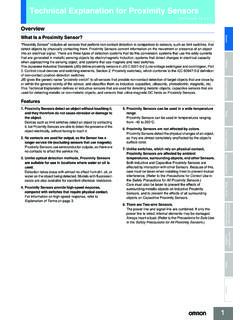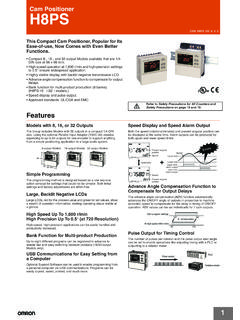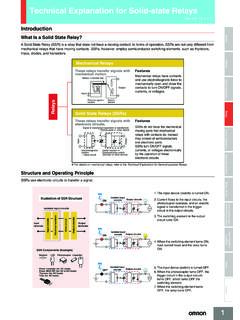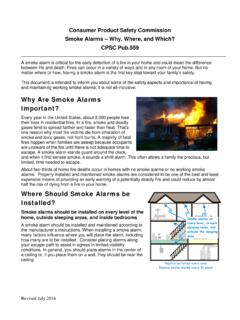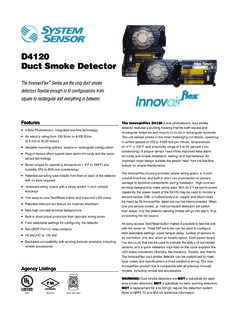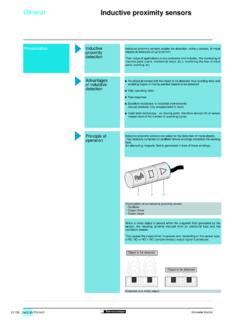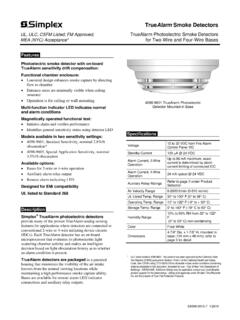Transcription of Photoelectric Sensors Technical Guide - Omron
1 Photoelectric Sensors Technical Guide9 Explanation of TermsItemExplanatory diagramMeaningSensing distanceThrough-beam SensorsThe maximum sensing distance that can be set with sta-bility for Through-beam and Retro-reflective Sensors , taking into account product deviations and temperature fluctuations. Actual distances under standard conditions will be longer than the rated sensing distances for both types of SensorsDiffuse-reflective SensorsThe maximum sensing distance that can be set with sta-bility for the Diffuse-reflective Sensors , taking into ac-count product deviations and temperature fluctuations, using the standard sensing object (white paper). Actual distances under standard conditions will be longer than the rated sensing SensorsAs shown in the diagram at left, the optical system for the Limited-reflective Sensors is designed so that the Emitter axis and the Receiver axis intersect at the surface of the detected object at an angle.
2 With this optical system, the distance range in which reg-ular-reflective light from the object can be detected con-sistently is the sensing distance. As such, the sensing distance can range from 10 to 35 mm depending on the upper and lower limits. (See page 7.)Mark Sensors (Contrast scanner)As shown in the diagram of the optical system at the left, a coaxial optical system is used that contains both an emitter and a receiver in one lens. This optical system provides excellent stability against fluctuations in the dis-tance between the lens and the sensing object ( , marks). (With some previous models, the emitter lens and receiver lens are separated.) The sensing distance is specified as the position where the spot is smallest ( , the center sensing distance) and the possible sensing range before and after that range/Sensing rangeDistance-settable SensorsLimits can be set on the sensing position of objects with Distance-settable Sensors .
3 The range that can be set for a standard sensing object (white paper) is called the "set range." The range with the set position limits where a sensing object can be detected is called the "sensing range." The sensing range depends on the sensing mode that is selected. The BGS mode is used when the sensing object is on the sensor side of the set position and the FGS mode is used when the sensing object is on the far side of the set position. (See page 6.)Directional angleThrough-beam Sensors , Retro-reflective SensorsThe angle where operation as a Photoelectric sensor is travelDiffuse-reflective and Distance-settable SensorsThe difference between the operating distance and the reset expressed in catalogs as a percentage of the rated sensing zoneThe dead zone outside of the emission and reception ar-eas near the lens surface in Mark Sensors , Distance-set-table Sensors , Limited-reflective Sensors , Diffuse-reflective Sensors , and Retro-reflective Sensors .
4 Detection is not possible in this timeThe delay time from when the light input turns ON or OFF until the control output operates or resets. In general for Photoelectric Sensors , the operating time (Ton) reset time (Toff).Sensing distanceReceiverEmitterEmitterandReceive rReflectorSensing distanceEmitterandReceiverSensingobjectS ensing distanceSensing objectEmitter beamReception areaEmitterandReceiverUpper end of thesensing distancerangeLower end of the sensingdistance range Emitter beamCenter sensingdistanceSensing objectSensing rangeEmitter andReceiverSet rangeSensingobjectSensing rangeEmitter and ReceiverEmitterDirectional angle ofthe EmitterReceiverSensingobjectOperatingdis tanceReset distanceONDifferential travelOFFE mitterandReceiverExample for Diffuse-reflective SensorEmission areaReception areaDead zoneLight inputControl outputOperatingtime (Ton)Reset time(Toff)
5 Photoelectric Sensors Technical Guide10 ItemExplanatory diagramMeaningDark-ON operationDARK ONThe "Dark-ON" operating mode is when a Through-beam sensor produces an output when the light entering the Receiver is inter-rupted or "Light-ON" operating mode is when a Diffuse-reflective Sen-sor produces an output when the light entering the Receiver operationLIGHT ONAmbient operating illuminationThe ambient operating illumination is expressed in terms of the Receiver surface illuminance and is defined as the illuminance when there is a 20% change with respect to the value at a light reception output of 200 lx. This is not sufficient to cause malfunc-tion at the operating illuminance sensingobjectThe standard sensing object for both Through-beam Sensors and Retro-reflective Sensors is an opaque rod with a diameter larger than the length of a diagonal line of the optical general, the diameter of the standard sensing object is the length of the diagonal line of the Emitter/Receiver lens for Through-beam Sensors , and the length of a diagonal line of the Reflector for Retro-reflective of Standard Sensing Object Using ReflectorFor Diffuse-reflective Sensors , the standard sensing object is a sheet of white paper larger than the diameter of the emitted.
6 Retro-reflective SensorsDiffuse-reflectiveSensorsPresentO perationNot presentSensing objectEmitterReceiverSensing objectEmitter and ReceiverOperationThrough-beam,Retro-refl ective SensorsPresentOperationNot presentSensing objectEmitterReceiverSensing objectOperationDiffuse-reflectiveSensors Emitter and ReceiverDifference between Ambient Operating Illuminationand Operating Illumination LimitReceived IlluminationWhite paperReflector lampLux meter 20%Received light outputfor 200 lxOperating level200 1,00010,000100,000 Illumination (lx)AmbientoperatingilluminationOperatio nillumination limit100%EmitterReceiverReceivedlight outputRetro-reflective SensorsRetroreflectorEmitter and ReceiverThe length of thediagonal of theReflectorDiffuse-reflective SensorsWhite paperEmitter and ReceiverEmission beamA bigger piece ofblank paper thanthe diameter ofthe Emitter beamThrough-beam SensorsThe length of thediagonal of theEmitter lens orReceiver lensEmitterReceiverReflector modelsDiagonal line of optical systemSensingobjectE39-R1/R1 mm75-mm mm105-mm mm45-mm mm30-mm mm60-mm mm45-mm mm70-mm mm40-mm mm55-mm mm110-mm mm15-mm Sensors Technical Guide11 Minimum sensing ob-jectTypical examples are given
7 Of the smallest object that can be de-tected using Through-beam and Retro-reflective Sensors with the sensitivity correctly adjusted to the light-ON operation level at the rated sensing Diffuse-reflective Sensors , typical examples are given of the smallest objects that can be detected with the sensitivity set to the highest sensing ob-jectwith slit at-tachedThrough-beam SensorsTypical examples are given of the smallest object that can be de-tected using Through-beam Sensors with a Slit attached to both the Emitter and the Receiver as shown in the figure. The sensi-tivity is correctly adjusted to the Light-ON operating level at the rated sensing distance and the sensing object is moved along the length and parallel to the diagramMeaningThrough-beam SensorsEmitterReceiverRetro-reflective SensorsReflectorEmitter and ReceiverDiffuse-reflective SensorsEmitter and ReceiverSlitSensing objectPhotoelectric Sensors Technical Guide14 Application and Data(1) Relationship of Lens Diameter and Sensitivity to the Smallest Detectable Object(2) Detecting Height DifferencesSelecting Sensors Based on Detectable Height Differences and Set Distances (Typical Examples)
8 With a Through-beam sensor , the lens diameter determines the size of the smallest object that can be detected. With a Through-beam sensor , a small object can be more easily detected midway between the Emitter and the Receiver that it can be off center between the Emitter and Receiver. As a rule of thumb, an object 30% to 80% of the lens diameter can be detected by varying the sensitivity level. Check the Ratings and Specifications of the sensor for size given for the smallest object that can be detected with a Reflective Photoelectric sensor is the value for detection with no objects in the background and the sensitivity set to the maximum sensitivityAdjusted sensitivityDetects objects 80% of the lens objects up to 30% of the lens of thelens diameterLensdiameter30% oflens diameterAppearanceFeaturesOptical FiberSensors Built-in Amplifier Sensors MicrosensorsSeparate Amplifier SensorsBuilt-in Amplifier SensorsBuilt-in AmplifierSensorsModelE32-L25LE3T-SL1@E3C -LS3RE3Z-LSE3S-CL1 SensingdistanceDifferencein to to mm4 to 20 mm to 4 to15 mm1130
9 3mm1840 to200 mm2040 to200 mm40 Photoelectric Sensors Technical Guide15(3) MSR (Mirror Surface Rejection) Function[Principles]This function and structure uses the characteristics of the Retroreflector and the polarizing filters built into the Retro-reflective Sensors to receive only the light reflected from the Retroreflector. The waveform of the light transmitted through a polarizing filter in the Emitter changes to polarization in a horizontal orientation. The orientation of the light reflected from the triangular pyramids of the Retroreflector changes from horizontal to vertical. This reflected light passes through a polarizing filter in the Receiver to arrive at the Receiver.
10 [Purpose]This method enables stable detection of objects with a mirror-like reflected from these types of objects cannot pass through the polarizing filter on the Receiver because the orientation of polarization is kept horizontal.[Examples]A sensing object with a rough, matte surface (example (2)) can be detected even without the MSR function. If the sensing object has a smooth, glossy surface on the other hand (example (3)), it cannot be detected with any kind of consistency without the MSR function.[Caution]Stable operation is often impossible when detecting objects with high gloss or objects covered with glossy film. If this occurs, install the sensor so that it is at an angle off perpendicular to the sensing object.

